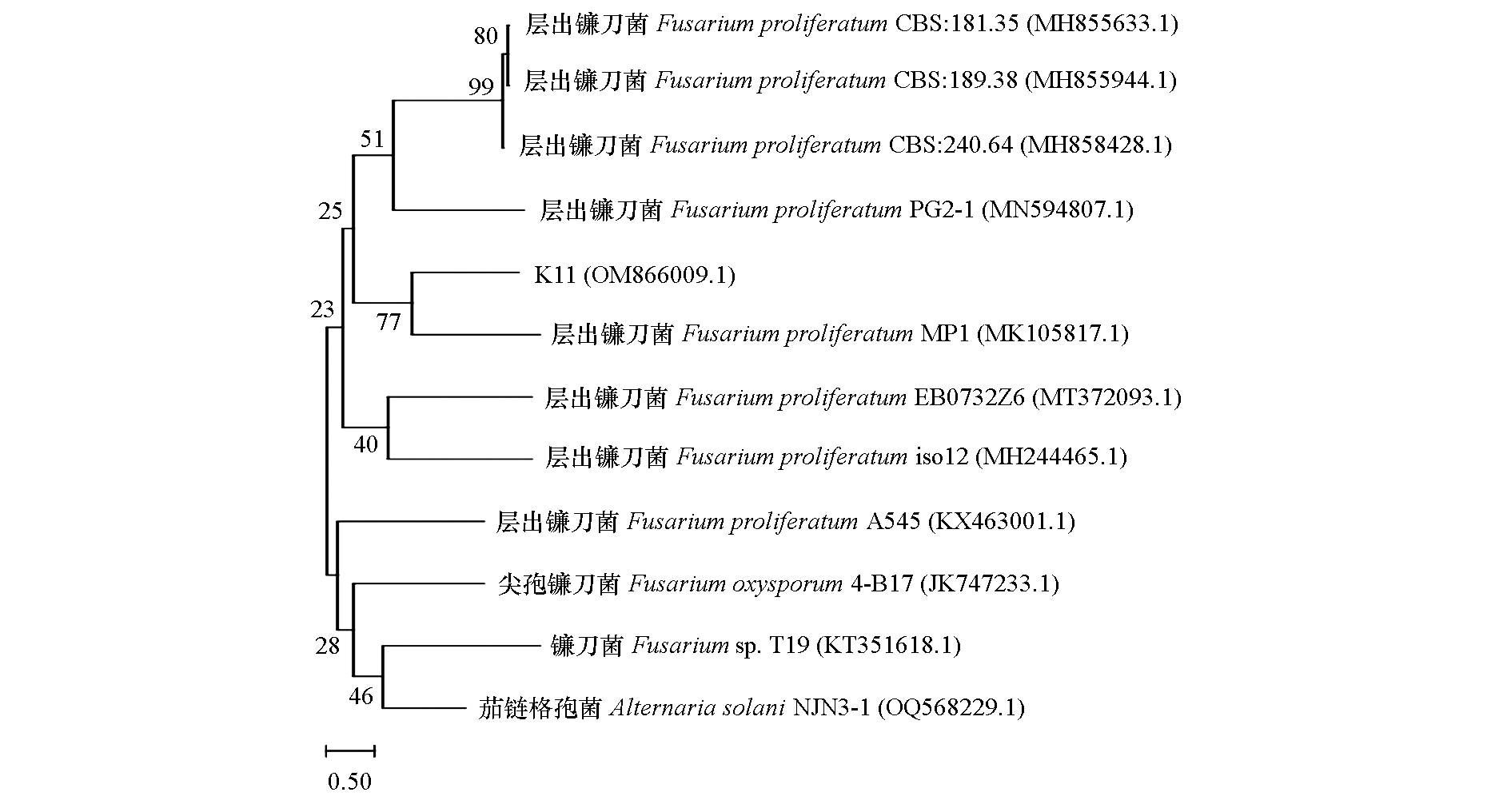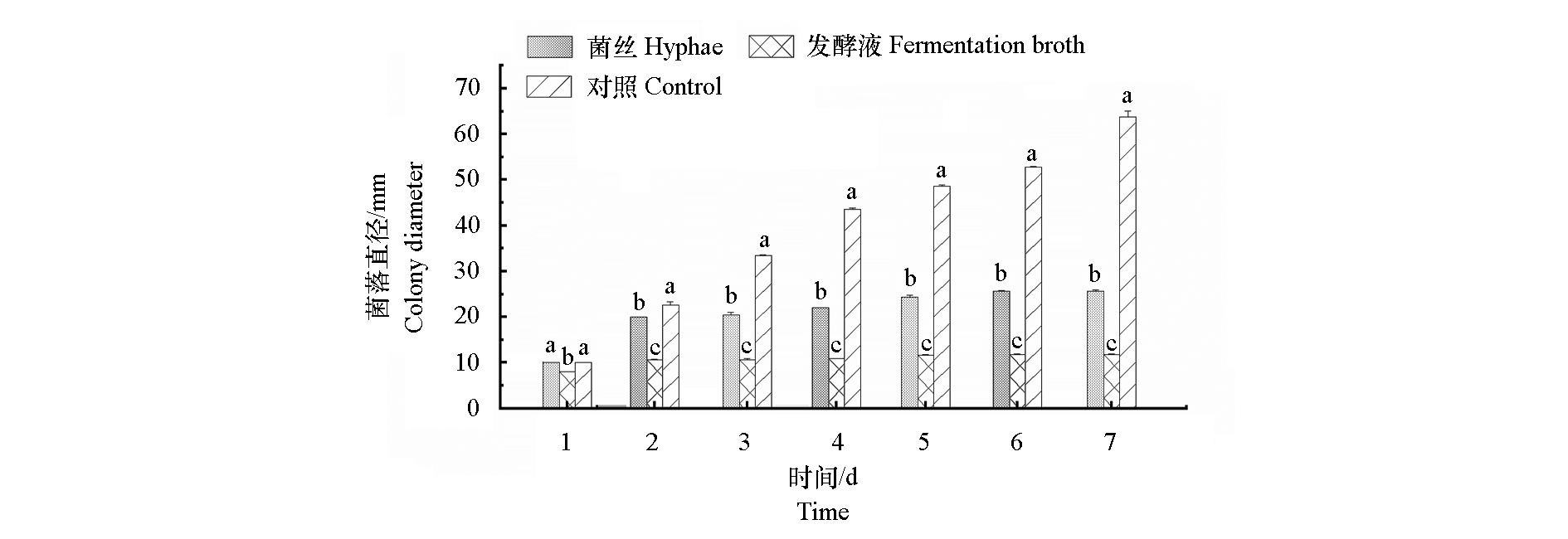
Acta Horticulturae Sinica ›› 2025, Vol. 52 ›› Issue (9): 2532-2544.doi: 10.16420/j.issn.0513-353x.2024-0811
• Plant Protection • Previous Articles Next Articles
SU Xiumin1,*( ), WANG Jiao1, HAN Wenqing1, LI Peng2, WANG Qiulan1, LI Wanxing1
), WANG Jiao1, HAN Wenqing1, LI Peng2, WANG Qiulan1, LI Wanxing1
Received:2024-12-02
Revised:2025-06-05
Online:2025-09-25
Published:2025-09-24
Contact:
SU Xiumin
SU Xiumin, WANG Jiao, HAN Wenqing, LI Peng, WANG Qiulan, LI Wanxing. Isolation,Biological Characteristics of the Pathogen Causing Fusarium Wilt on Tomato and Antagonistic Fungus Screening[J]. Acta Horticulturae Sinica, 2025, 52(9): 2532-2544.
Add to citation manager EndNote|Ris|BibTeX
URL: https://www.ahs.ac.cn/EN/10.16420/j.issn.0513-353x.2024-0811

Fig. 1 Symptoms of Fusarium and colony morphology A:Colony morphology of primary isolates;B:Colony morphology after purification;C:Dissection section symptom of stem;D:Symptoms at the later period of infection

Fig. 4 The phylogenetic tree of the strain K11 based on ITS sequence The number on each branch point represents the bootstrap;The scale bar represents the evolutionary distance

Fig. 5 Colony diameters of the K11 strain under different growth conditions(the 7th day) Different lowercase letters indicate significant differences among different treatments at 0.05 level

Fig. 8 The colony diameters of K11 confrontation cultured Trichoderma harzianum M408 and Fusarium proliferatum strain K11(1-7 d) Different lowercase letters indicate significant differences among different treatments at 0.05 level
| [1] |
|
| [2] |
|
| [3] |
|
|
陈云云, 李慧霞, 张海英, 徐生军, 刘永刚. 2021. 萎缩芽孢杆菌 MQ19ST15 鉴定及对甘蓝枯萎病的盆栽防效. 植物保护, 47 (5):64-71.
|
|
| [4] |
|
|
方中达. 1998. 植病研究方法. 3版. 北京: 中国农业出版社:63.
|
|
| [5] |
|
|
葛晓颖, 孙志刚, 李涛, 欧阳竹. 2016. 设施番茄连作障碍与土壤芽孢杆菌和假单胞菌及微生物群落的关系分析. 农业环境科学学报, 35 (3):514-523.
|
|
| [6] |
|
|
郭珺, 武爱莲, 闫敏, 李娓, 池秀蓉, 丁玉川, 焦晓燕. 2016. 芽孢杆菌Pb-4菌株鉴定及其抑菌活性的研究. 华北农学报, 31 (2):224-230.
doi: 10.7668/hbnxb.2016.02.036 |
|
| [7] |
|
| [8] |
doi: 10.11686/cyxb20150321 |
|
李兴龙, 李彦忠. 2015. 土传病害生物防治研究进展. 草业学报, 24 (3):204-212.
doi: 10.11686/cyxb20150321 |
|
| [9] |
|
|
梁雪杰, 张婷婷, 乔俊卿, 杜艳, 刘邮洲. 2014. 番茄土传病害拮抗菌的筛选、评价及鉴定. 西南农业学报, 27 (3):1096-1103.
|
|
| [10] |
|
|
孟臻, 张伟萍, 王莹, 李龙, 姬小雪, 董贝, 乔康. 2022. 番茄枯萎病菌 RT-PCR 检测技术的建立与应用,园艺学报, 49 (11):2479-2488.
|
|
| [11] |
|
| [12] |
|
| [13] |
|
| [14] |
|
|
沈海斌, 王前程, 陈捷, 吴珏, 杨学东, 朱为民, 张迎迎. 2023. 三株木霉对番茄枯萎病的防治效果和机理研究. 植物生理学报, 59 (5):965-976.
|
|
| [15] |
|
| [16] |
|
| [17] |
|
| [18] |
|
|
谭娇娇, 王喜刚, 郭成瑾, 张丽荣, 沈瑞清. 2021. 哈茨木霉M-17固体发酵及发酵产物浸提液对镰刀菌的抑制作用. 西北农业学报, 30 (11):1741-1747.
|
|
| [19] |
|
|
田淼, 彭玉飞, 吕红, 秦楠, 任璐, 殷辉, 赵晓军. 2023. 非洲哈茨木霉LMNS-M9 的鉴定、生物学特性及其对藜麦的促生作用. 微生物学通报, 50 (9):3848-3865.
|
|
| [20] |
|
| [21] |
|
|
王恩泽. 2020. 番茄枯萎病拮抗菌的筛选及其抑菌效果研究[硕士论文]. 哈尔滨: 东北农业大学.
|
|
| [22] |
|
|
王飞, 杨瑾, 李雪梦, 赵莹, 刘玉霞, 秦艳红, 高素霞, 文艺, 鲁传涛. 2024. 牛膝枯萎病病原鉴定、生物学特性及防治药剂筛选. 植物病理学报, 54 (1):49-58.
doi: 10.13926/j.cnki.apps.001602 |
|
| [23] |
|
|
王桂清, 曾路, 马迪, 赵鹏. 2018. 我国近10年植物致病真菌生物学特性研究综述. 江苏农业科学, 46 (19):1-5.
|
|
| [24] |
|
|
王璐瑶. 2017. 生防解淀粉芽胞杆菌B1619生物学特性、诱导抗病性和田间应用技术研究[硕士论文]. 南京: 南京农业大学.
|
|
| [25] |
|
|
王前程, 张迎迎, 戴陶宇, 尤佳琪, 郭世荣, 朱为民. 2022. 拟康宁木霉T-51菌株对番茄枯萎病的生物防治及其机理研究. 西北植物学报, 42 (6):974-982.
|
|
| [26] |
|
|
王全华, 李景富, 李永镐, 王富. 1996. 黑龙江省番茄枯萎病菌生理小种鉴定. 东北农业大学学报, 27 (4):354-357.
|
|
| [27] |
|
|
王永强. 2020. 解淀粉芽孢杆菌SDTB009的分离鉴定及其对番茄枯萎病的防治研究[硕士论文]. 泰安: 山东农业大学.
|
|
| [28] |
|
|
肖辉, 程文娟, 张鹏, 张慧, 焦汝民, 王立艳, 赵杰, 潘洁. 2021. 木醋液与杀菌剂复配对番茄枯萎病和灰霉病的防治效果. 江苏农业科学, 49 (1):82-87.
|
|
| [29] |
|
|
徐艳辉, 李烨, 许向阳. 2008. 番茄枯萎病的研究进展. 东北农业大学学报, 39 (11):128-134.
|
|
| [30] |
|
| [31] |
|
|
张斌, 乔俊卿, 梁雪杰, 刘邮洲, 陈志谊. 2015. 番茄枯萎病菌和青枯病菌拮抗细菌的评价. 植物保护学报, 42 (3):353-361.
|
|
| [32] |
|
|
张亮, 盛浩, 袁红, 赵兰凤, 李华兴. 2017. 荧光假单胞菌PEF-5#18防控番茄枯萎病的定殖机理. 中国生物防治学报, 33 (5):658-666.
doi: 10.16409/j.cnki.2095-039x.2017.05.012 |
|
| [33] |
|
|
张文静, 徐大勇, 吴倩琳, 杨佛, 信丙越, 曾昕, 李峰. 2024. 拮抗番茄灰霉病的贝莱斯芽孢杆菌XDY66基因组分析. 园艺学报, 51 (6):1413-1425.
|
|
| [34] |
|
|
周东兴, 王恩泽, 刘多, 金聪敏, 李欣, 姜姗, 白皓天. 2020. 番茄枯萎病生防细菌的筛选及对植株防御酶活性的影响. 生态学杂志, 39 (5):1753-1760.
|
|
| [35] |
|
|
周晗. 2018. 芽孢杆菌sigX因子防治番茄青枯病和香蕉枯萎病的研究[硕士论文]. 广州: 华南农业大学.
|
| [1] | FAN Huidong, ZHENG Shijin, TIAN song, ZHENG Jianchao. A New Tomato F1 Hybrid‘Jifen 7’ [J]. Acta Horticulturae Sinica, 2025, 52(S1): 109-110. |
| [2] | ZHANG Liwei, DAI Zhongren, CHEN Qingqi, LEI Na, HUANG Jun, Hu Haijiang, MEN Wanjie. A New Tomato Cultivar‘Hayan Zhongfenguo 1’ [J]. Acta Horticulturae Sinica, 2025, 52(S1): 111-112. |
| [3] | XIONG Zili, SHI Jianlei, CHEN Yongbing, ZHANG Haili, SU Shiwen, ZAI Wenshan, YE Shuguang. A New Tomato Cultivar‘Ouxiu 202’ [J]. Acta Horticulturae Sinica, 2025, 52(S1): 113-114. |
| [4] | CHEN Shuting, WU Mumian, LI Tao, LI Zhenxing, MAI Peiting, SUN Baojuan, HAO Yanwei, GONG Chao. Effects of EM Bacteria on Tomato Yield and Soil Bacterial Community [J]. Acta Horticulturae Sinica, 2025, 52(9): 2477-2490. |
| [5] | SONG Qi, SONG Xiaoya, JIAO Yongxin, MAO Ziyue, WU Xiaogang, ZHANG Qingxia. Antifungal Activity of Pseudomonas protegens FD6 Against Botrytis cinerea and Optimization of Its Culture Conditions [J]. Acta Horticulturae Sinica, 2025, 52(9): 2545-2553. |
| [6] | ZHOU Ming, HAN Chenxu, YUAN Guoliang, FAN Xiaoqing, AI Pengfei, and LI Changbao. Research Progress of Tomato Male Sterility and Its Breeding Application [J]. Acta Horticulturae Sinica, 2025, 52(8): 2081-2098. |
| [7] | LI Dandan, GE Pingfei, LI Fangman, YANG Yang, XU Haobo, XIONG Chunhui, and ZHANG Yuyang. Regulatory Genes for Tomato Flavor and Their Application in Quality Improvement [J]. Acta Horticulturae Sinica, 2025, 52(8): 2099-2113. |
| [8] | GUAN Sihui, LIU Chenxu, ZHOU Guozhi, WAN Hongjian, RUAN Meiying, WANG Rongqing, YE Qingjing, LI Zhimiao, YAO Zhuping, and CHENG Yuan. Advances in Volatile Flavor Compounds of Cultivated Tomato Fruit and Factors Influencing Its Flavor Quality [J]. Acta Horticulturae Sinica, 2025, 52(8): 2114-2132. |
| [9] | ZHANG Ruiyi, FENG Wenjia, LI Benben, SONG Yiying, WEI Mingyue, CHAI Guaiqiang, and HUO Yanbo. Cloning and Functional Analysis of Cuticular Wax Synthesis Gene SlCER1-7 in Tomato [J]. Acta Horticulturae Sinica, 2025, 52(7): 1733-1744. |
| [10] | REN Xiaoyan, JIA Yiwei, WANG Luwei, LI Tianshuang, LIU Haixia, YAO Yanping, WANG Chunwei, and WANG Meiqin. Detection and Risk Resistance Assessment of Botrytis cinerea on Tomatoes to Prochloraz [J]. Acta Horticulturae Sinica, 2025, 52(7): 1915-1925. |
| [11] | FANG Junyi, WU Weifeng, LU Qiao, LING Hongqing, and KONG Danyu. Screening and Identification for Bacterial Wilt Resistance Accession TK083 in Tomato [J]. Acta Horticulturae Sinica, 2025, 52(6): 1477-1487. |
| [12] | XIAO Zhihao, ZHENG Hankai, ZHANG Mannan, TANG Huaiqian, WANG Jiaying, ZHANG Yuyang, ZHANG Junhong, YE Zhibiao, and YE Jie. Effects of Potassium on Growth and Development of Tomato Seedlings Under Abiotic Stress [J]. Acta Horticulturae Sinica, 2025, 52(6): 1599-1618. |
| [13] | LU Xiuping, TANG Zhichao, TANG Wenkun, Mao Feifeng, ZHANG Wanping, LI Jingwei. Identification of Infectivity of 13 Viroid RNA and DNA Genomes of Tomato [J]. Acta Horticulturae Sinica, 2025, 52(3): 749-760. |
| [14] | WANG Chunwei, WANG Yan, DUAN Tiankun, SU Yaxin, YUAN Shengnan, REN Lu, ZHAO Xiaojun, WANG Meiqin. Antifungal Mechanism of Isooctyl Alcohol on Botrytis cinerea Causing Tomato Gray Mold [J]. Acta Horticulturae Sinica, 2025, 52(3): 761-772. |
| [15] | GAO Xin, ZHAO Longlong, YU Qiang, JI Jiayue, WEI Jie, LU Haoyue, WEI Mingfeng, MA Ruiyan. Effects of Four Pear Species and Their Biological Characteristics on the Oviposition of Pear Psylla [J]. Acta Horticulturae Sinica, 2025, 52(1): 13-24. |
| Viewed | ||||||
|
Full text |
|
|||||
|
Abstract |
|
|||||
Copyright © 2012 Acta Horticulturae Sinica 京ICP备10030308号-2 国际联网备案号 11010802023439
Tel: 010-82109523 E-Mail: yuanyixuebao@126.com
Support by: Beijing Magtech Co.Ltd